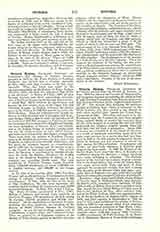

Victoria Nyanza, Vicariate Apostolic of NORTHERN.—The Mission of Victoria Nyanza, founded in 1878 by the White Fathers of Cardinal Lavigerie, was erected into a vicariate Apostolic May 31, 1883, with Msgr. Livinhac as the first vicar Apostolic. When the latter was raised to the superior-generalship of the Society of White Fathers (October, 1889), the Holy See appointed Msgr. Hirth as his successor. A Decree of July 6, 1894, divided Victoria Nyanza into three autonomous missions: that of Southern Nyanza in the German Protectorate, of which Msgr. Hirth retained the government and became the first titular; those of the Upper Nile and Northern Nyanza, in English territory, the former given to the Fathers of Mill Hill and the second to the White Fathers. From the 18 provinces of Uganda the Decree of 1894 detached that of Kyaggive and Kampala Mengo, which it placed under the jurisdiction of the Fathers of Mill Hill, and gave to Northern Nyanza the remaining 17 provinces of the Kingdom of Uganda, the three Kingdoms of Unyoro, Toro, and Ankole, and in the Belgian Congo an isosceles triangle whose top was the northern point of Lake Albert Nyanza and whose base followed the 30th degree of longitude. Three races share the portion of Northern Nyanza lying in the English protectorate; the first, that of the Baganda, is represented by 670,000 inhabitants, and has given the strongest support to evangelization, and in 1886 had the courage and the honor to give to the Church its first negro martyrs. The second race, the Banyoro, is represented by 520,000 aborigines; the third, the Bahima (Hamites), the leading class in the shepherd Kingdom of Ankole, is in a minority not exceeding 50,000 souls. The total population of Northern Nyanza equals therefore about 1,500,000 inhabitants, of whom 1,400,000 are in English territory, and 360,000 in the Congo country.
At the time of its creation (July, 1894) Northern Nyanza had an administrator, 17 missionaries divided among 5 stations, 15,000 neophytes and 21,000 catechumens. In July, 1896, the date of the death of Msgr. Guillerman, the first vicar Apostolic, the vicariate had 6 stations, 21 missionaries, and 20,000 baptized Christians. In July, 1911, it had 1 bishop, Msgr. Henri Streicher (preconized February 2, 1897), Bishop of Tabarca and second vicar Apostolic of Southern Nyanza, 118 missionaries divided among 28 stations, 113,810 neophytes and 97,630 catechumens. All the missionaries of Northern Nyanza, including the vicar Apostolic, are members of the Society of White Fathers founded by Cardinal Lavigerie. As yet the native clergy consists only of 2 subdeacons, 4 minor clerics, and 4 tonsured clerics. They are assisted by 28 European religious of the Society of White Sisters, and by an institute of native religious called the Daughters of Mary. Eleven hundred and five Baganda and Banyoro teachers cooperate in the educational work and in the service of 832 churches or chapels. The Vicariate of Northern Nyanza has 894 scholastic establishments, viz. a lower seminary with 80 students, and upper seminary with 16 students in philosophy and theology, a high school with 45 pupils, most of them the sons of chiefs, a normal school with 62 boarders, and 890 primary schools in which free instruction is given to 19,157 pupils, of whom 11,244 are boys and 7913 girls. The annual report of the vicar Apostolic from June, 1910, to June, 1911, shows 7930 confirmations, 1154 marriages, 578,657 confessions heard, 1,236,126 communions administered, and the gratuitous distribution of 394,495 remedies. The headquarters of the mission is at Villa Maria, near Masaka, Uganda. There are situated the residence of the bishop, the two seminaries, a flourishing mission station, the central house of the White Sisters, the novitiate of the native sisters, and a printing establishment where there is published monthly in the Ruganda language an interesting 16-page magazine entitled “Munn”, which has 2000 native subscribers. Entebbe is the seat of the procurator of the vicariate.
HENRY STREICHER

